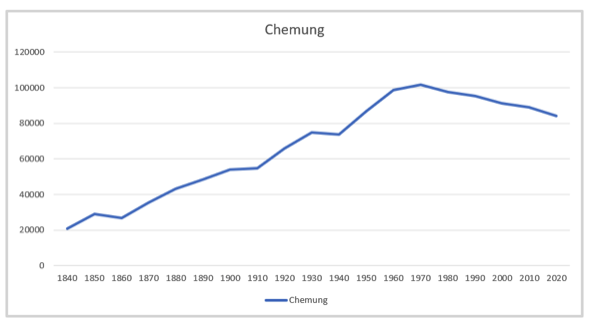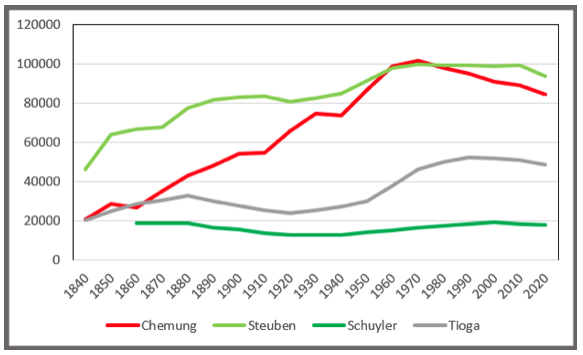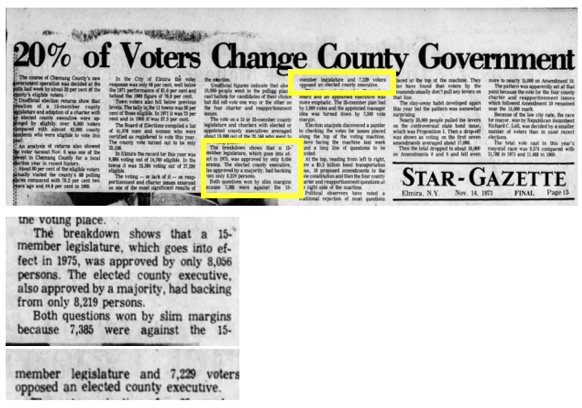The Implications of Declining Population
In the State of New York (and particularly upstate), over a million and a half residents migrated to other states in the last decade (8% of the state’s population – barely offset by birth and foreign immigration rates). In 2018, as NYS led the nation in this “population outflow”, Governor Andrew Cuomo denied claims that a failing economy due to poor government leadership could be responsible for the decline. Instead, he blamed the weather.
“Somebody wants to move to Florida because they want to move to Florida.
God bless them. They want to fish. They want warm weather."
Pundits found that premise questionable at best. As many academics and analysts noted: Since we’ve seen net “population inflow” in several cold states like Washington, Maine, Montana, New Hampshire, and Minnesota.... “warm weather” can’t be the only reason Florida and Texas have seen “inflows”.
There is a direct correlation between population growth and economic prosperity, and New York State has seen a decline in both over the last decade.
Chemung County’s population drain has been longer and bigger than NYS’s exodus. From the peak of 101,000 residents in the 1970 census, we have lost over 17% of our county population.
The History We’ve Heard About
Like Cuomo pointing to Florida’s balmy temperatures, the weather has been unfairly scapegoated for local “population outflow”.
It’s been repeatedly stated by local leaders over the years that the primary factor in Chemung County’s decline was the devastating flood that Hurricane Agnes hurled upon us in June of 1972. We’ve been told for nearly 50 years that Agnes’s destruction was simply too much to overcome.
It’s unmistakable that Chemung County enjoyed over a century of growth prior to the 1972 flood and encountered a sharp downturn in population from that time forward. The economic prosperity that fosters population growth didn’t rebound after that event.

With this timeline in mind, the theory that “Agnes was our downfall” seemed plausible and has been widely accepted by most people in the area.
The Contrasts That Have Been Overlooked
Similar to Cuomo’s “cold weather” excuse overlooking population growth in other cold climate states, the pretext that Agnes is to blame for all our woes neglects to explain why other counties devastated by Agnes managed to recover, but not Chemung County.
Residents and businesses didn’t flee Steuben County after the destruction of Hurricane Agnes, and since 2010 Steuben’s population decreased by just 6% compared to Chemung County’s 17% plummet. Meanwhile, the populations in Schuyler and Tioga Counties (also struck hard by Agnes) have increased by 6% and 4% respectively.

It’s worth mentioning that decades before Agnes, another record-breaking flood in 1946 laid waste to Chemung County, and the economy continued to boom afterward. Chemung County was able to recover and realize its sharpest population growth ever – with a 38% increase from 1940 to 1970.
So, if Agnes isn’t at fault for our state of affairs....then what else occurred during the 1970s that could have hindered Chemung County’s growth?
The Parallel Event That Shaped Chemung County’s Circumstances
There is one change to Chemung County’s circumstances that the county did not face during its recovery from the 1946 flood: abolishing the established government structure that had resolved county issues for over a century (Board of Supervisors) and replacing it with a “new” and more politically motivated governing body in a 1973 Charter proposal.
That change didn’t have much voter support at all. It was defeated by public vote in 1972 and when four different reapportionment and charter proposals were placed on the ballot in November 1973, the current 15-member Legislature and elected Executive options was finally approved by just over 8,000 votes (less than 20% of voters – with a margin of under 1,000 votes).

As we approach the 50th anniversary of Hurricane Agnes.....it’s worth considering whether the transformation of local government may have done harm to Chemung County’s fate that has lingered decades after the flooding.
The Value of The Board of Supervisors
What impact did the (largely unpopular) shift in County Government have on the “Efficiency of County Government Operations”?
As the people charged with everyday issues and challenges of their individual municipalities, members of the Board of Supervisors had solid roots and commitment to their individual communities. They had the qualification of understanding what services and needs their Town spends its resources on.....and where those resources come from.
Whether it was one of our communities with a local police department or public water and streetlights or a community that’s home to retail, agriculture, or industrial enterprises. The people tasked with (and have the most understanding of) weighing the priorities of each municipality within the county are those who comprised the Board of Supervisors.
The adopted County Charter that abolished the Board of Supervisors and established a separate Legislature created a new layer of bureaucracy, disconnected from the Supervisors who fully realize the needs of their communities. The adopted Charter goes so far as to prohibit municipal officials from the “new” bureaucratic arrangement.
“No mayors of cities or villages, supervisors of towns, or members of the legislative body of cities, towns or villages who reside in the County shall be eligible to be elected as members of the County Legislative body.”
Legislators can only grasp the needs of individual municipalities by getting second-hand input. Aside from being time-consuming and inefficient...that information is usually degraded as it passes through multiple channels.
In order to examine the impact County actions have on various city, town and village concerns, legislators can either consult the very Supervisors who are excluded from serving on the body....or (as is increasingly common) commission a “study” from a third party. The latter option adds expense to taxpayers (as if the $1 million added expenses of legislature pay and benefits isn’t punitive enough)....for information that the Supervisors already manage and fully comprehend.
Whether it’s New York State or Chemung County, it’s dishonest to blame the weather for the steady departure of residents. There’s a high probability that if Chemung County had kept its Board of Supervisors, it would have recovered (like other counties did) from the damage Agnes caused. And it’s fair to ask if returning to that structure (or otherwise modifying the current legislative structure) could finally right the ship
Opportunities To Remedy Ineffective Government Operations
So....how does a change back to a more efficient county government happen?
In recent years, the Legislature has reviewed the “merit” of several of (its own) policies that benefit its members. Not surprisingly....the body (often steered by committees with members vocally opposing changes) has a pattern of concluding that “self-preservation” of the Legislature is best for their constituents.
2019 “Legislature Compensation & Benefits Review Committee”: Over some objections, the decision was made to continue their 16k+ per year salaries and full health plan participation for their parttime (well under 20 hours/wk) duties
2020 “Term Limit Advisory Committee”: a panel (chosen by a Chair who is a career politician, serving his third term and vocally opposed to term limits) determined that the county is best served by allowing legislators to have an unlimited number of terms.
2021/22 “Legislative Redistricting & Efficiency of County Government Operations Advisory Committee”: From the beginning, this committee has pointedly avoided the question (cited as one of their points to consider) of balancing the number of legislative districts to the declining population (which would result in some number of “their” legislative seats being removed).
Action That Citizens Can Take
So if self-interest and preservation are clearly prevalent when these matters are left to the Legislative body....how can the electorate compel the Legislature to address transformational propositions that the body is averse to confronting on its own?
Petition for a referendum on amending the Charter. We have seen pleas from dozens of citizens speak on these topics, often fall on deaf ears. Regardless of whether any members are inclined to support the reforms, it’s clear that the Legislature (at the behest of the Chair) is under no compulsion to comply with requests received from constituents, either by letter or public comment.
However, the body is required to take action when properly petitioned.
As outlined by the Department of State “Adopting and Amending County Charters”, the New York State Municipal Home Rule Law does provide a process for voters to bring about reform.
“A proposed charter or proposed revision of an existing charter may be prepared by or under the auspices of the county’s governing body directly or by a specifically appointed charter commission. The charter drafting process may be initiated by the governing body itself or by voter petition and referendum.”
*****
Voter initiative. Under a procedure set forth in section 33 of the Municipal Home Rule Law, the voters of a county may petition the county legislative body to establish and appoint a charter commission. The petition calling for the creation of the charter commission must be signed by qualified voters equal in number to at least 10 percent of the votes cast in the county for Governor in the last gubernatorial election.
In response to such a petition, the legislative body may create and appoint a charter commission on its own motion. Otherwise, the county legislative body is required by law to submit to a referendum the question of whether a charter commission should be established and appointed. If a majority of the votes cast on the question are in favor of the proposition, the legislative body must create a commission and appoint its members within two months following voter approval.”
A petition signed by ten percent of the 30-40,000 Chemung County voters who typically participate in the general elections seems like a high bar but is by no means insurmountable. If voters want a choice in how the county government operates, initiating a Charter Amendment is an attainable prospect; it works out to roughly 200-300 signatures for each of our 15 legislative districts.
This could be accomplished by three dozen advocates each gathering signatures from 100 registered voters and would require the Legislature to offer a public referendum to amend the charter....which the Legislature has been averse to presenting on their own accord.
Kathleen Reed is a Town of Catlin resident.
-
 3
3


2 Comments
Recommended Comments
Create an account or sign in to comment
You need to be a member in order to leave a comment
Create an account
Sign up for a new account in our community. It's easy!
Register a new accountSign in
Already have an account? Sign in here.
Sign In Now